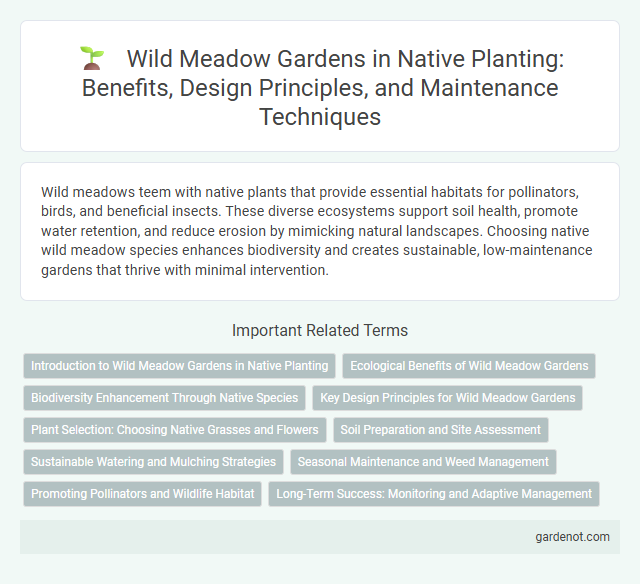Wild meadows teem with native plants that provide essential habitats for pollinators, birds, and beneficial insects. These diverse ecosystems support soil health, promote water retention, and reduce erosion by mimicking natural landscapes. Choosing native wild meadow species enhances biodiversity and creates sustainable, low-maintenance gardens that thrive with minimal intervention.
Introduction to Wild Meadow Gardens in Native Planting
Wild meadow gardens showcase a rich diversity of native grasses, wildflowers, and perennials that support local ecosystems by providing habitat and food for pollinators and wildlife. Incorporating native species such as purple coneflower (Echinacea purpurea), black-eyed Susan (Rudbeckia hirta), and little bluestem (Schizachyrium scoparium) enhances soil health and reduces maintenance needs. These sustainable landscapes promote biodiversity, improve water retention, and adapt naturally to regional climate conditions.
Ecological Benefits of Wild Meadow Gardens
Wild meadow gardens support biodiversity by providing habitat and food sources for pollinators, birds, and beneficial insects, fostering ecosystem stability. Native grasses and wildflowers improve soil health through deep root systems that enhance water retention and reduce erosion. These meadows also contribute to carbon sequestration, playing a role in climate regulation and environmental sustainability.
Biodiversity Enhancement Through Native Species
Wild meadows planted with native species significantly boost biodiversity by providing habitat and food sources for pollinators, birds, and small mammals. Native plants support local ecosystems by fostering complex relationships within the soil microbiome and native fauna, enhancing ecological resilience. This biodiversity enhancement leads to more sustainable and self-regulating meadow ecosystems compared to non-native plantings.
Key Design Principles for Wild Meadow Gardens
Wild meadow gardens thrive by prioritizing soil health, native plant selection, and seasonal diversity to create resilient, low-maintenance ecosystems. Incorporating a mix of native grasses and wildflowers enhances biodiversity and supports local pollinators throughout the year. Strategic layering with varying plant heights and bloom times fosters habitat complexity and visual interest while promoting natural regeneration.
Plant Selection: Choosing Native Grasses and Flowers
Selecting native grasses and flowers for wild meadows enhances local biodiversity by supporting pollinators and wildlife adapted to the region. Native species like little bluestem, switchgrass, coneflowers, and black-eyed Susans provide resilience to local climate and soil conditions while requiring minimal maintenance. Prioritizing a diverse mix of perennial grasses and flowering plants ensures seasonal interest and ecological balance within the meadow ecosystem.
Soil Preparation and Site Assessment
Assess soil texture, pH, and organic matter content to ensure optimal conditions for wild meadow planting, favoring well-drained, moderately fertile soils. Remove existing vegetation and till the soil to a depth of 4-6 inches to promote root establishment and improve aeration. Conduct a site assessment for sunlight exposure and drainage patterns, as wild meadows thrive in full sun with consistent moisture but avoid waterlogged conditions.
Sustainable Watering and Mulching Strategies
Wild meadow native planting thrives with sustainable watering techniques such as drip irrigation and rainwater harvesting, which minimize water waste and promote deep root growth. Mulching with organic materials like wood chips or straw conserves soil moisture, regulates temperature, and suppresses weeds, enhancing plant health. These strategies support biodiversity and reduce maintenance by creating resilient, water-efficient ecosystems.
Seasonal Maintenance and Weed Management
Seasonal maintenance of wild meadows involves regular mowing or selective cutting during late summer to prevent woody plant encroachment and promote native species growth. Effective weed management requires early identification and removal of invasive species through hand-pulling or targeted herbicide applications to reduce competition for resources. Maintaining a diverse plant palette supports ecosystem resilience and enhances habitat quality for pollinators and wildlife.
Promoting Pollinators and Wildlife Habitat
Wild meadows composed of native plants create essential habitats that support diverse pollinators like bees, butterflies, and hummingbirds. These ecosystems provide nectar, pollen, and shelter, fostering biodiversity and enhancing ecological resilience. Integrating wild meadows into landscapes contributes to wildlife conservation and natural pest control by attracting beneficial insects.
Long-Term Success: Monitoring and Adaptive Management
Wild meadow ecosystems thrive through continuous monitoring and adaptive management strategies that ensure long-term success by addressing changes in plant composition and environmental conditions. Implementing regular site assessments allows for early detection of invasive species, nutrient imbalances, and hydrological shifts, which can then be managed through targeted interventions such as selective mowing, controlled burns, or supplemental planting. These adaptive practices promote biodiversity, resilience, and sustainability in native wild meadow restorations.
Wild meadow Infographic

 gardenot.com
gardenot.com